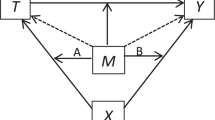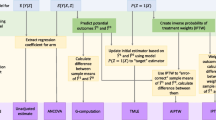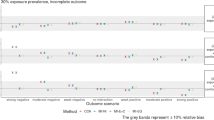Abstract
We present the results of a Monte Carlo simulation study in which we demonstrate how strong baseline interactions between a confounding variable and a treatment can create an important difference between the marginal effect of exposure on outcome (as estimated by an inverse probability of treatment weighted logistic model) and the conditional effect (as estimated by an adjusted logistic regression model). The scenarios that we explored included one with a rare outcome and a strong and prevalent effect measure modifier where, across 1,000 simulated data sets, the estimates from an adjusted logistic regression model (mean β = 0.475) and an inverse probability of treatment weighted logistic model (mean β = 2.144) do not coincide with the known true effect (β = 0.68925) when the effect measure modifier is not accounted for. When the marginal and conditional estimates do not coincide despite a rare outcome this may suggest that there is heterogeneity in the effect of treatment between individuals. Failure to specify effect measure modification in the statistical model appears to results in systematic differences between the conditional and marginal estimates. When these differences in estimates are observed, testing for or including interactions or non-linear modeling terms may be advised.
Similar content being viewed by others
References
Rothman KJ, Greenland S. Modern epidemiology. Philadelphia: Lippincott Williams & Wilkins; 1998.
Clayton D, Hills M. Statistical models in epidemiology. Oxford: Oxford University Press; 1993.
Suissa S. Novel approaches to pharmacoepidemiology study design and statistical analysis. In: Strom BL, editor. Pharmacoepidemiology. Sussex: Wiley; 2000. p. 785–805.
Robins JM, Hernán MA, Brumback B. Marginal structural models and causal inference in epidemiology. Epidemiology. 2000;11:550–60. doi:10.1097/00001648-200009000-00011.
Hernán MA, Brumback B, Robins JM. Marginal structural models to estimate the causal effect of zidovudine on the survival of HIV-positive men. Epidemiology. 2000;11:561–70. doi:10.1097/00001648-200009000-00012.
Cole SR, Hernán MA, Robins JM, Anastos K, Chmiel J, Detels R, et al. Effect of highly active antiretroviral therapy on time to acquired immunodeficiency syndrome or death using marginal structural models. Am J Epidemiol. 2003;158:687–94. doi:10.1093/aje/kwg206.
Mortimer KM, Neugebauer R, van der Laan MJ, Tager IB. An application of model-fitting procedures for marginal structural models. Am J Epidemiol. 2005;162:382–8. doi:10.1093/aje/kwi208.
Brumback BA, Hernán MA, Haneuse SJ, Robins JM. Sensitivity analyses for unmeasured confounding assuming a marginal structural model for repeated measures. Stat Med. 2004;23:749–67. doi:10.1002/sim.1657.
Hernán MA, Taubman SL. Does obesity shorten life? The importance of well-defined interventions to answer causal questions. Int J Obes Lond. 2008;32(Suppl 3):S8–14. doi:10.1038/ijo.2008.82.
Cole SR, Hernán MA. Constructing inverse probability weights for marginal structural models. Am J Epidemiol. 2008;168:656–64. doi:10.1093/aje/kwn164.
Hernán MA, Robins JM. Estimating causal effects from epidemiological data. J Epidemiol Community Health. 2006;60:578–86. doi:10.1136/jech.2004.029496.
Bryan J, Yu Z, van der Laan MJ. Analysis of longitudinal marginal structural models. Biostatistics. 2004;5:361–80. doi:10.1093/biostatistics/kxg041.
Stürmer T, Rothman KJ, Glynn RJ. Insights into different results from different causal contrasts in the presence of effect-measure modification. Pharmacoepidemiol Drug Saf. 2006;15:698–709. doi:10.1002/pds.1231.
Gail MH, Wieand S, Piantadosi S. Biased estimates of treatment effect in randomized experiments with nonlinear regressions and omitted covariates. Biometrika. 1984;7:431–44. doi:10.1093/biomet/71.3.431.
Austin PC. The performance of different propensity score methods for estimating marginal odds ratios. Stat Med. 2006;26:3078–94. doi:10.1002/sim.2781.
Austin PC, Grootendorst P, Normand SL, Anderson GM. Conditioning on the propensity score can result in biased estimation of common measures of treatment effect: a Monte Carlo study. Stat Med. 2007;26:754–68. doi:10.1002/sim.2618.
Greenland S, Robins JM, Pearl J. Confounding and collapsibility in causal inference. Stat Sci. 1999;14:29–46. doi:10.1214/ss/1009211805.
Greenland S. Interpretation and choice of effect measures in epidemiologic analyses. Am J Epidemiol. 1987;125:761–8.
Newman SC. Commonalities in the classical, collapsibility and counterfactual concepts of confounding. J Clin Epidemiol. 2004;57:325–9. doi:10.1016/j.jclinepi.2003.07.014.
Kurth T, Walker AM, Glynn RJ, Chan KA, Gaziano JM, Berger K, et al. Results of multivariable logistic regression, propensity matching, propensity adjustment, and propensity-based weighting under conditions of nonuniform effect. Am J Epidemiol. 2006;163:262–70. doi:10.1093/aje/kwj047.
Burton A, Altman DG, Royston P, Holder RL. The design of simulation studies in medical statistics. Stat Med. 2006;25:4279–92. doi:10.1002/sim.2673.
Maldonado G, Greenland S. The importance of critically interpreting simulation studies. Epidemiology. 1997;8:453–6.
Martens EP, Pestman WR, Klungel OH. Conditioning on the propensity score can result in biased estimation of common measures of treatment effect: a Monte Carlo study (p n/a). Stat Med. 2007;26:3208–10. doi:10.1002/sim.2878.
Robins JM, Hernán MA, Rotnitzky A. Invited Commentary: effect modification by time-varying covariates. Am J Epidemiol. 2007;166:994–1002. doi:10.1093/aje/kwm231.
Petersen ML, Deeks SG, Martin JN, van der Laan MJ. History-adjusted marginal structural models for estimating time-varying effect modification. Am J Epidemiol. 2007;166:985–93. doi:10.1093/aje/kwm232.
Delaney JAC, Daskalopoulou SS, Suissa S. Traditional versus marginal structural models to estimate the effectiveness of β-blocker use on mortality after myocardial infarction. Pharmacoepidemiol Drug Saf. 2008;. doi:10.1002/pds.1676.
Schneeweiss S. Sensitivity analysis and external adjustment for unmeasured confounders in epidemiologic database studies of therapeutics. Pharmacoepidemiol Drug Saf. 2006;15:291–303. doi:10.1002/pds.1200.
Greenland S. Basic methods for sensitivity analysis of biases. Int J Epidemiol. 1996;25:1107–16. doi:10.1093/ije/25.6.1107-a.
Acknowledgments
RP is the recipient of a Chercheur-boursier award from the Fonds de Recherche en Santé du Québec. SS is the recipient of a Distinguished Investigator Award from CIHR.
Author information
Authors and Affiliations
Corresponding author
Rights and permissions
About this article
Cite this article
Delaney, J.A.C., Platt, R.W. & Suissa, S. The impact of unmeasured baseline effect modification on estimates from an inverse probability of treatment weighted logistic model. Eur J Epidemiol 24, 343–349 (2009). https://doi.org/10.1007/s10654-009-9341-z
Received:
Accepted:
Published:
Issue Date:
DOI: https://doi.org/10.1007/s10654-009-9341-z




